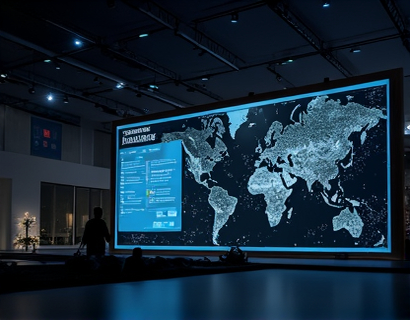Next-Gen Engagement Codes: Transforming Business and Social Media Interaction
In the rapidly evolving digital landscape, businesses and social media managers are constantly seeking innovative ways to enhance engagement and deepen connections with their audience. One such solution that has emerged is the next-generation of QR Codes, often referred to as advanced QR Codes or interactive codes. These codes are not just a simple upgrade; they represent a significant leap forward in how information is shared and interacted with online. This article delves into the features, benefits, and practical applications of these advanced QR Code solutions, designed to elevate business and social media interactions.
Understanding Advanced QR Codes
Traditional QR Codes have been a staple in digital marketing and information sharing for years. However, they have limitations, such as limited data capacity and a static nature that does not allow for real-time updates. Advanced QR Codes, on the other hand, are engineered to overcome these limitations. These codes can store significantly more data, including URLs, text, contact information, and even multimedia content. Moreover, they can be dynamically updated, allowing businesses to refresh content without the need to create new codes.
Customization and User-Friendliness
One of the most significant advantages of advanced QR Codes is their customization options. Businesses and social media managers can tailor these codes to match their brand identity, incorporating logos, colors, and designs that resonate with their target audience. This level of personalization not only enhances the visual appeal but also reinforces brand recognition. Additionally, the user-friendly interfaces provided by platforms specializing in these codes make it easy to generate, manage, and track QR Code usage, even for those with limited technical expertise.
Enhanced Data Capacity
The increased data capacity of advanced QR Codes is a game-changer. While traditional QR Codes can store up to 2,000 numeric characters or 1,056 alphanumeric characters, next-generation codes can hold much more. For instance, some advanced codes can store up to 7,089 alphanumeric characters. This expanded capacity allows businesses to include detailed information such as product specifications, customer testimonials, and comprehensive FAQs. The ability to provide rich, detailed content in a single, scannable code enhances the user experience and reduces the need for multiple links or pages.
Real-Time Updates and Dynamic Content
Dynamic content is a key feature of advanced QR Codes. Unlike static codes, these codes can be updated in real-time, allowing businesses to keep their information current and relevant. For example, a company can use a dynamic QR Code to promote a limited-time offer, and as the promotion ends, the code can be updated to reflect a new deal or a different product. This flexibility ensures that the content remains fresh and engaging, encouraging repeat scans and sustained interaction.
Multi-Functionality and Versatility
Advanced QR Codes are not limited to a single function. They can serve multiple purposes within a single code, making them highly versatile. For instance, a QR Code can direct users to a landing page, provide a video tutorial, and offer a downloadable PDF guide all at once. This multi-functionality streamlines the user journey, reducing friction and increasing the likelihood of conversion. Whether it's for marketing campaigns, event promotions, or educational content, the versatility of these codes makes them an invaluable tool.
Enhancing Customer Engagement on Social Media
Social media platforms are prime areas for leveraging advanced QR Codes to boost engagement. By placing these codes on posts, stories, or even physical event materials, businesses can create interactive experiences that drive users to take action. For example, a QR Code on a social media post can lead to a live Q&A session, a behind-the-scenes video, or an exclusive discount offer. This not only increases engagement but also fosters a sense of community and loyalty among followers.
Tracking and Analytics
One of the most valuable aspects of advanced QR Codes is the built-in tracking and analytics capabilities. Platforms that generate these codes provide detailed insights into how and when the codes are scanned, where they are used, and what actions users take after scanning. This data is crucial for understanding customer behavior and optimizing marketing strategies. Businesses can use these insights to refine their content, target specific audience segments more effectively, and measure the ROI of their engagement efforts.
Security and Trust
Security is a paramount concern in the digital age, and advanced QR Codes address this by incorporating secure elements. These codes can include encrypted links and verify the authenticity of the content they direct to. This ensures that users are directed to safe and trusted sources, building confidence and trust. For businesses, this means a lower risk of negative experiences that could harm their reputation.
Environmental and Cost Efficiency
Advanced QR Codes also offer environmental and cost benefits. By consolidating multiple pieces of information into a single code, businesses reduce the need for printed materials, thereby minimizing waste. Additionally, the digital nature of these codes eliminates the costs associated with printing, distributing, and updating physical materials. This makes them an eco-friendly and cost-effective solution for businesses looking to reduce their environmental footprint and operational expenses.
Case Studies and Real-World Applications
Several businesses across various industries have successfully implemented advanced QR Codes to enhance customer engagement. For instance, a retail brand used dynamic QR Codes on product tags to provide customers with detailed product information, reviews, and purchase options. This not only improved the shopping experience but also increased sales by 15% within three months. In the hospitality sector, a hotel chain placed QR Codes on room keys that led to a virtual concierge service, offering guests personalized recommendations and services, resulting in a 20% increase in guest satisfaction scores.
Implementing Advanced QR Codes
To integrate advanced QR Codes into your business or social media strategy, follow these steps:
- Choose a reliable platform that offers customizable and dynamic QR Codes.
- Design your QR Code to align with your brand identity.
- Input the desired content, ensuring it is concise and valuable to your audience.
- Test the QR Code to ensure it functions correctly and directs to the intended destination.
- Place the QR Code in strategic locations, both online and offline, where your audience is likely to encounter it.
- Monitor the analytics to gain insights and optimize your strategy based on user interactions.
Conclusion
Advanced QR Codes represent a significant advancement in digital engagement tools, offering businesses and social media managers a powerful way to connect with their audience. With their enhanced data capacity, real-time updates, multi-functionality, and built-in analytics, these codes provide a comprehensive solution for modern engagement challenges. By embracing this technology, businesses can create more interactive, personalized, and effective interactions, ultimately driving greater engagement and loyalty. As the digital landscape continues to evolve, advanced QR Codes will undoubtedly play a crucial role in shaping the future of customer engagement.










































